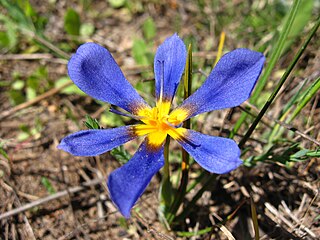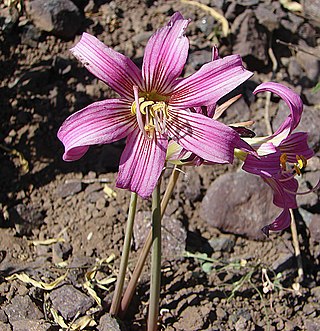| Tristagma | |
|---|---|
 | |
| Tristagama patagonicum | |
| Scientific classification | |
| Kingdom: | Plantae |
| Clade: | Tracheophytes |
| Clade: | Angiosperms |
| Clade: | Monocots |
| Order: | Asparagales |
| Family: | Amaryllidaceae |
| Subfamily: | Allioideae |
| Tribe: | Gilliesieae |
| Genus: | Tristagma Poepp. |
| Type species | |
| Tristagma nivale | |
| Synonyms [1] | |
| |
Tristagma is a genus of South American plants in the onion subfamily with the Amaryllis family. [3] It is native to South America (Peru, Argentina, Chile and Uruguay) but one of the species (T. uniflorum) has become naturalized in various other places. [1] [4]
- Species [1]
- Tristagma ameghinoi (Speg.) Speg. - Mendoza + Santa Cruz Provinces of Argentina
- Tristagma anemophilum Ravenna - Neuquén Province of Argentina
- Tristagma atreucoense Ravenna - Neuquén Province of Argentina
- Tristagma bivalve (Hook. ex Lindl.) Traub - central Chile
- Tristagma brevipes (Kuntze) Traub - central Chile
- Tristagma circinatum (Sandwith) Traub - Neuquén Province of Argentina
- Tristagma fragrans Ravenna - central Chile
- Tristagma gracile (Phil.) Traub - central Chile
- Tristagma graminifolium (Phil.) Ravenna - central Chile
- Tristagma leichtlinii (Baker) Traub - central Chile
- Tristagma lineatum Ravenna - Santiago Region of Chile
- Tristagma lomarum Ravenna - Arequipa Region of Peru
- Tristagma malalhuense Ravenna - Mendoza Province of Argentina
- Tristagma mirabile Ravenna - Neuquén Province of Argentina
- Tristagma nahuelhuapinum Ravenna - Rio Negro Province of Argentina
- Tristagma nivale Poepp. - central + southern Chile, southern Argentina
- Tristagma patagonicum (Baker) Traub - southern Argentina
- Tristagma peregrinans Ravenna - Uruguay
- Tristagma philippii Gand. - central Chile
- Tristagma poeppigianum (Gay) Traub - central Chile
- Tristagma porrifolium (Poepp.) Traub - central Chile
- Tristagma sessile (Phil.) Traub - Chaco Province of Argentina, central Chile, Uruguay
- Tristagma sociale Ravenna - Mendoza Province of Argentina
- Tristagma staminosum Ravenna - O'Higgins Region of Chile
- Tristagma tweedieanum (Baker) Traub - Uruguay, northeastern Argentina
- Tristagma uniflorum (Lindl.) Traub - Uruguay, eastern Argentina; naturalized in Great Britain, France, Australia, New Zealand, Oregon, California, southeastern United States (from Texas to Maryland)
- Tristagma yauriense Ravenna - Puno Province of Peru
- formerly included [1]
Several names have been coined using the name Tristagma but referring to species now considered better suited other genera (Beauverdia, Leucocoryne, and Nothoscordum).
- Tristagma dimorphopetalum - Leucocoryne dimorphopetala
- Tristagma felipponei - Beauverdia sellowiana
- Tristagma hirtellum - Beauverdia hirtella
- Tristagma lloydiiflorum - Beauverdia vittata
- Tristagma lorentzii - Beauverdia lorentzii
- Tristagma narcissoides - Leucocoryne coronata
- Tristagma sellowianum - Beauverdia sellowiana
- Tristagma setaceum - Nothoscordum setaceum
- Tristagma subbiflorum - Nothoscordum bivalve
- Tristagma vittatum - Beauverdia vittata













